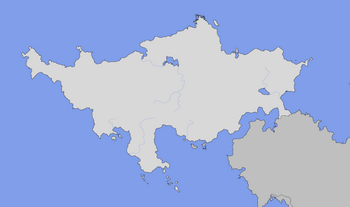Storsnia
This article is incomplete because it is pending further input from participants, or it is a work-in-progress by one author. Please comment on this article's talk page to share your input, comments and questions. Note: To contribute to this article, you may need to seek help from the author(s) of this page. |
The United Republic of Storsnia Storsyan Yhdistynyt Tasavalta | |
|---|---|
|
Flag | |
Motto: Pohjoiset valot yhdistävät meidät kaikki The Northern Lights Unite Us All | |
 Official Map of The United Republic of Storsnia | |
| Capital | Farsund |
| Largest | Ensrup |
| Official languages | Storsne |
| Recognised regional languages | Skolt |
| Demonym(s) | Storsnian |
| Government | Federal semi-direct democracy under a parliamentary republic |
• First Minister | Kállá Tamvere |
• Deputy First Minister | Villiam Tapio |
| Legislature | Chamber of Representatives |
| Establishment | |
• Foundation of the Storsne Confederacy | XXXX |
• Velvet Revolution | XXXX |
• Constitution Reform of 19XX | 19XX |
| Area | |
• | 2,873,680.16 km2 (1,109,534.11 sq mi) (1st) |
| Population | |
• Estimate | 17,342,000 (36th) |
• Density | 6.0/km2 (15.5/sq mi) |
| GDP (nominal) | 2019 estimate |
• Total | $180 billion |
• Per capita | $10,379 |
| Currency | Istap ((SIT)) |
| Date format | ddmmyyyy |
| Driving side | right |
| Calling code | +206 |
| Internet TLD | .st |
Storsnia (Storsne: Storsyan), officially the United Republic of Storsnia (Storsne: Storsyan Yhdistynyt Tasavalta), is a nation in Northeastern Nori bordered by the Gulf of Salta to the West and the Titus Ocean to the North. The capital is Farsund and the largest city is Ensrup. Other major metropolitan areas include Nilsiä and Kaskinen.
Storsnia's population is about 17,342,000, the majority of whom live on the West Coast and the South Central Highlands. A majority of the population speaks Storsne with some speaking a regional dialect known as Skolt in the rural North and Northeast. Storsnia is the largest nation on the Nori continent by land area and the third least populated. It is a Federal Parliamentary Republic made up of nine cantons.
The first Storsne were very nomadic and followed the migratory patterns of the native reindeer. These first peoples began to settle down and beginning a long standing tradition of reindeer herding around 561. There were many different tribes among the Storsne that would fight for good herding grounds and arable land which proved to be scarce in the northern parts of the country. Eventually, the larger tribes subdued many of the smaller ones. The leaders of these tribes saw that a war between themselves would be devastating and that they would be stronger if they were united under a single entity. Thus the Storsne Confederacy was formed. For many years the hereditary chiefs of the tribes that made up the confederacy were representatives of their people. However, as the population grew the chiefs got wealthier and worked to serve themselves rather then protecting their people. Corruption soon became quite rampant and bribery was not uncommon. The population was upset after a news article exposed several confederacy officials and the Velvet Revolution occurred devastating the confederacy. The Velvet Revolution was a success and resulted in Storsnia adopting their current government and reforming into a federal parliamentary republic rather then a confederacy. Representatives were no longer the hereditary chiefs. Representatives became elected officials. In the early 1900s the government went through some major reforms introducing the directly democratic ideas it still follows today.
Etymology
The original native name for Storsnia was Stoeaporossnyan, which roughly translates to "land of snow and reindeer", owing to the large amounts of snow in the area during winter and the vast herds of reindeer that served as a major food source for early Storsne. The first Storsne in this area referred to themselves as Stoeagasdanek which translates to "farmers of snows", this comes from how the early Storsne saw themselves as farmers reaping the few benefits brought by the frequent snow weather. Over time both of these names became shortened to Storsyan and Storsne respectively.
Today the proper way to refer to a citizen of Storsnia is "Storsnian".
